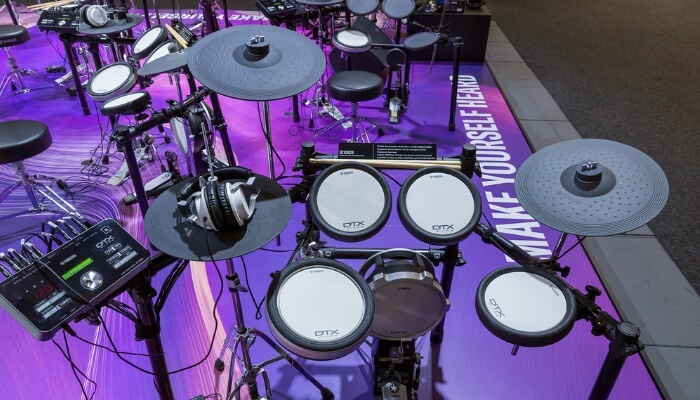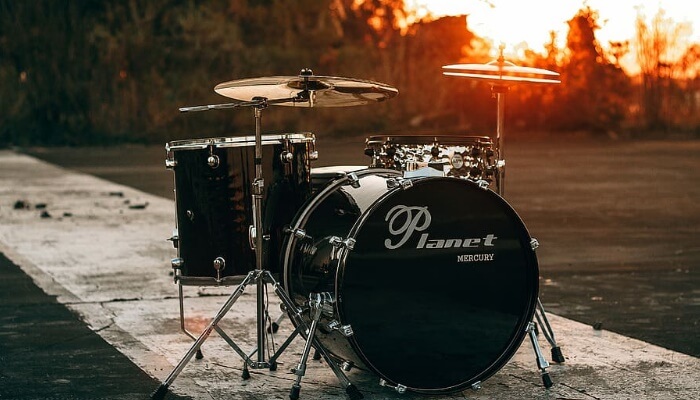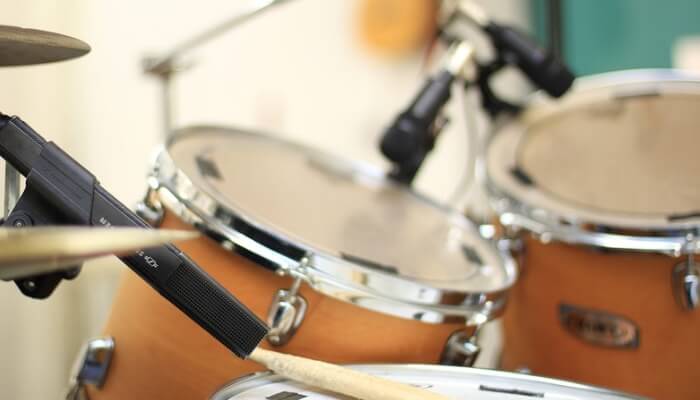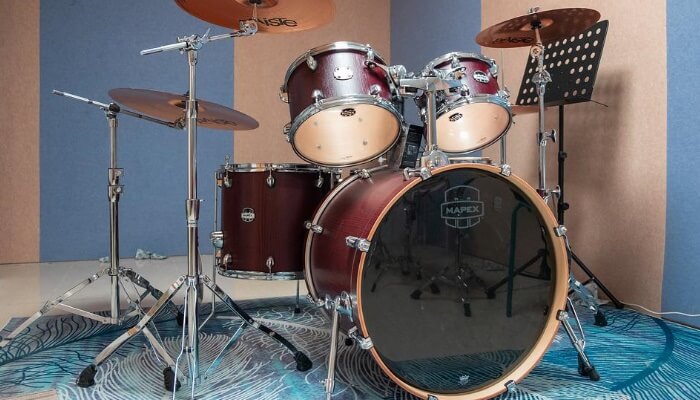Beginner drummers must have many questions regarding the differences between electronic drums vs acoustic drums. If you are among them, this article will be a must-read.
These drums are different in their setup, design, sound, and many other factors. If you want to settle on one option, start by comparing them side by side.
This article will walk you through the differences between the drums. Let’s join us and determine the winner!
Electronic Drums
An electronic drum set has a drum and some cymbal pads connected to a module. Hitting the pads can activate the module to create sounds.
You can listen to these sounds via headsets or an amplifier.
Pros
Low/zero volume: When it comes to loudness control, these instruments come out on top with a rate of 60-75 dB. You can also use noise reducers to lower the volume.
Metronome: A metronome comes with many of these kits, which is essential for increasing your tempo. Some even offer practice features for the best performance.
Excellent for recording: These drums have a much wider range of sounds. You have many options, such as a percussion kit or a dance kit.
Various sounds: High-end drums feature a wide variety of rhythms and sounds, making them ideal for many musical genres and styles.
Easy to transport: These models are portable. They often have modest striking pads to help you move them quickly. Moreover, its bulk and weight are low.
Easy to set up: You can set up the drums quickly because of the simple design and compact size.
Cons
Poor response: Many low-cost electronic drums lack the necessary feeling and reaction. As a result, performing on them will not feel authentic, and you will miss out on the dynamics and feel of an acoustic set.
Not entirely quiet: The drums aren’t silent. Even if you play them in a flat, striking the pads can make some noise that your neighbor can hear.
Bad habits: When drumming on an electronic set, drummers may have bad habits.
The drums allow you to control their volume so that you can learn how to play too loudly or softly. Unfortunately, this habit reduces the feeling you need for dynamics.
Moreover, the pads produce excessive bounce, impairing how you play when switching to another version.
Sound from cymbals: The most common problem with these models is cymbals. Although their samples have significantly improved, modeling cymbals digitally is extremely tough.

Acoustic Drums
A set of acoustic drums includes a bass drum, a snare drum, some toms, two cymbals (for riding and crashing), and the hardware. Some models may have extra features, such as more cymbals or toms.
Pros
Excellent sound depth: Acoustic drums have a much wider dynamic range and more delicate nuances than electronic drums. Rim shots, cymbal bells, ghost notes, and other elements sound considerably better on an acoustic kit.
Acoustic music: This set is the sole technically acceptable option for performing live in various acoustic music genres, including jazz and rock.
It’s also possible to experience electronic sounds by integrating MIDI (Musical Instrument Digital Interface) triggers.
Cymbals: Acoustic cymbals are pretty interesting to play and hear. In comparison to these, electronic cymbals might sound pretty flat.
Stage presence: The presence of an acoustic drum setup on stage is stunning.
Cons
Loud noise: Sound from these drums can reverberate across a whole neighborhood at 90-120 dB. Different heads, dampers, and sticks of various types can significantly affect the sound.
Hard to transport: These models are pretty big and take up a lot of space, making them difficult to transport.
Maintenance: You need to clean and check the components in the set regularly to make sure that they can work properly.
Rising price: The set cannot provide the same range of sounds as an electronic set. You’ll need to spend money if you demand an entirely different drum and cymbal.

Electronic Drums Vs Acoustic Drums
We have broken down the differences between the drums into nine parts. Please check them one by one and choose the winner in each round.
Noise
Electronic sets are the definite winner when it comes to audio control systems. Nothing can beat this kit if you want instruments for your home recording.
Meanwhile, an acoustic drum kit’s sound can resonate throughout a neighborhood. The sound may be pretty harsh even when utilizing drum softening techniques.
Space
The size of an electronic drum kit is considerably less than that of its competitor, making it easier to set up and move around.
On the other hand, the acoustic drums are bulky. Make sure that your studio or stage can accommodate the whole setup.
Portability
Another easy win for electronic models, as most contemporary sets for beginners fold down into a compact, nearly flatpack configuration.
Meanwhile, the acoustic option rarely packs down and usually requires separate cases for each drum. Its hardware and cymbals also need cases for storing and transporting.

Cost
These drums can cost anywhere from $300 to $2,000. You can opt for cheaper instruments. Yet, expect lower quality from your purchases.
The difference in the price of these kits is that a low-quality acoustic kit can still sound good with minimal care. On the other hand, if you buy an electronic kit at a low cost, it may be subpar, and you can’t do much to improve it.
Another critical difference is that you can buy an excellent acoustic kit with a low price tag. Yet, only buy used electronic kits if you can ensure that all the components are in good working order because their replacements are expensive.

Features
The electronic kit shines out in this round. It includes all aces in the competition, such as DSP effects, MIDI, audio output, and adjustable onboard sounds.
Moreover, you can also have training and coaching tools, which bring a big value to new drummers. You can practice your speed, consistency, and timing skills by performing play-along tracks.
Playability
A set of acoustic drums is unbeatable when it comes to playability. Its responsiveness and sensitivity help you strike cymbals on the edges.
You can also use brushes or mallets to reduce nuance while playing. They are valuable features to improve the entire performance.
On the other hand, the responsiveness and feel of an electronic kit are quite limited. The modern models have rim shots and ghost notes, but they can’t defeat their competitors in terms of feel.
Playing live
If you have an acoustic set, you can shine on the stage with jazz, rock, and many other electric or acoustic genres.
Meanwhile, the electronic sets don’t always produce the most lively sounds. They may require amplification to yield better effects.
However, the e-drums have MIDI output to trigger velocity-sensitive synths and samplers. You can use it with the hardware or software of the host laptop.

Recording
The samples included in cheap e-drums won’t cut it as a proper acoustic kit modeling in the recording studio or on stage. Yet, the MIDI output is a must-have feature.
When you link it to your computer, you can utilize these pads to trigger powerful sampling kit plugins like Toontrack’s Drummer 2 and FXpansion’s BFD3. You can also take advantage of the artistic freedom that MIDI editing offers.
In the meantime, recording your acoustic kit requires a powerful pair of microphones, a qualified engineer, and a well-prepared recording area, which should be a studio.
Moving from one to the other
Drummers who are used to playing on electronic drums may find it challenging to adapt to acoustic sets. You have to get familiar with the processes of cymbals and the instrument’s response.
No matter what drum set you choose, you can develop all your rhythm fundamentals, which are essential for getting started.
You can sharpen your skills day after day by working on musicality, articulation, and dynamics. Then, moving from one instrument to the other becomes easier.
Do not rush your practice and training sessions. Instead, start with simple lessons to get used to your instrument and then work your way up.
Here are some basic drum lessons that beginners should focus on first:

Verdict
So what should you choose? This comparison table will help summarize what we have discussed and make an informed decision.
| Criteria | Acoustic Drums | Electronic Drums |
| Noise | Resonated and quite harsh | Good control system |
| Space | More space | Less space |
| Portability | Hard to transport | Easy to transport |
| Cost | Still good at a low price | Not advisable to buy at a low price |
| Features | More features | Fewer features |
| Playability | Excellent | Moderate |
| Playing live | Excellent sound effect | Limited sound effect |
| Recording | Complicated | Simple |
| Moving from one to the other | Easy to move to the electronic set | Hard to move to the acoustic set |
If the loudness from the drums isn’t an issue for you, and you are OK with the expense of upkeep and resources, an acoustic drum set is a terrific place to start.
On the other hand, an electronic drum set is the best solution if you want to practice silently or have different choices for sound.
Conclusion
Acoustic drums provide a superior feel, functionality, and live shows. On the other hand, electronic drums are excellent for reducing noise and using different drum sounds.
Hopefully, you will find this article helpful for your investment. Remember to consider your requirements before purchasing.
Thank you for reading!
